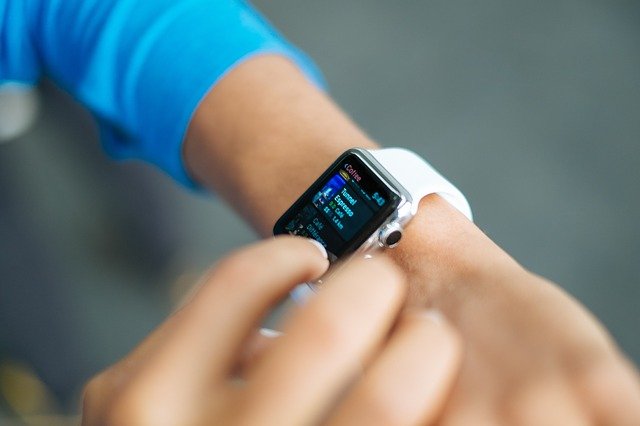
Currently, there are 165,000+ mobile health apps available. Among these apps, about 160 are FDA cleared. More than 500 million smartphone users worldwide currently use a health care app. It is estimated that the whole industry worth $26 billion by the end of 2017.
Users usually need to enter gender, DOB, weight, height, and goals when using health and fitness apps. The apps may require smartphone’s hardware, such as accelerometer, GPS, camera, diary, microphone/speaker and laser light.
Users can sync health apps wirelessly with wristband/heart rate/ belt/shoe sensor, or smart clothing. Some apps provide virtual coaches, which inspire users and make them feel like someone is there.
Some apps can be personalized. For example, the “Nike+Running” app can encourage you after you run a 5k: “Hi. I’m Shalane Flanagan. I may not have the record for the fastest American 5k, but that was an impressive run!”
The more popular apps have animations of the correct way to exercise, such as gym workouts, resistance training, jogging, bicycling, rowing, step aerobics, and X-training.
Things to look for in a good app
- User-friendly interface
- Free trial version
- Easy to initiate
- Reliable
- Allows goal setting
- Real-time personalized feedback
- Customized to user’s skill-fitness level
- Expert consultation available
- Evidence-based behavior change techniques
- Syncs with other apps/devices for easy review and sharing of stats
- Music playlist integration (iTunes, Pandora, Spotify etc)
- Social media networking
- Periodic summaries
Recommended health and fitness apps
| Category | App Name | Use |
| Fantasy | Zombies, Run! | Increase aerobic exercise (running, jogging) by providing an adventure mission to complete. Interval training, walking, jogging, and favorite songs can also be incorporated. |
| Intense Cardio | Strava Running and Cycling | Tracks running and cycling. The user can compare their performance on social media with friends, professionals, and network locally to find popular places to run or ride. |
| Nike+ Running | Tracks indoor (treadmill) or outdoor running and coaches user to complete races (5 kilometer to marathon). Provides in-run audio feedback of mile split metrics including time, miles, calories, elevation, average pace, and number of runs. | |
| RunKeeper | Tracks all aerobic exercises and weight loss. Synchronizes with 70 other apps including Fitbit, Fitocracy and MyFitnessPal’s Calorie Counter, and synchronizes with devices as well (e.g. Fitbit activity monitoring device). | |
| Runtastic | Tracks running and other aerobic exercises (biking, walking), including interval training, target pace and challenge running. It shows the users route on a map, provides one mile split times, distance, duration, speed, elevation change, and calories burned. | |
| Tracking and analytics | Map My Fitness | Workout trainer with 600 exercises, tracks running, cycling, and calories (input and output). Synchronizes with heart rate, speed, cadence and power sensors from CycleOps, Wahoo, Polar, Garmin, Fitbit, Nike+ and others. |
| Fitbit | Tracks exercises, food intake, net calories, weight, and sleep. Provides weekly summaries to users featuring steps, miles, calories burned, calories consumed, and weight. | |
| Run with Map My Run | Tracks multiple aerobic and resistance exercises including running, cycling, cardio, jogging, walking, and gym workouts. For outdoor activities, it provides pace, elevation, calories burned, and split-times. | |
| Fitocracy | Tracks workouts and motivates through extensive social network sharing. Expert guidance with virtual coaches is available, and team fitness routines can be chosen. | |
| Net weight loss | Lose It! | Creates customized weight loss plan based on users goals (weight, body fat, hydration, sleep, exercise, nutrients, hip/waist measurements). It accurately tracks food calories as well as calories burned with exercise. |
| MyFitnessPal’s Calorie Counter | Tracks food calorie intake by barcode scanner and exercises can be entered to monitor net calories. It also tracks major nutrients (fat, protein, carbohydrates), sugar, fiber, and cholesterol. | |
| Noom Weight Loss Coach | Tracks energy in (food calories) and out (exercise), and provides evidence-based weight loss strategies. Intelligent coaching keeps the user motivated with instant feedback, wellness articles, and healthy recipes daily appropriate for their goals. | |
| Eating/diet | Fitocracy Macros | Separately tracks macronutrients in the diet (protein, fat, carbohydrates) to help user achieve dieting goals. Counts fiber, water, alcohol, and can synchronize with Fitocracy, so it is also able to report energy expenditure. |
| Fooducate | Ranks overall nutrition value of food item from grade A (great) to D (avoid) and suggests alternative for unhealthy food choices. Customized to the user’s age, gender, weight, height, activity level, desired weigh loss rate, diet goals, health conditions, and special diets e.g. gluten free, vegan, and allergens. | |
| Sleep | Sleep Cycle alarm clock | Tracks sleep quality & quantity, including sounds (snoring) and motion (restlessness); also optimizes wake up interval. Users can also see how different daily activities (exercise, caffeine consumption, alcohol) impact their sleep. |
| Specialized | Couch-to-5K | Takes a non-exerciser and prepares them to run a 5 kilometer (3.1 mile) race in 3 months’ time. Includes a training plan, 4 different motivating virtual coaches, real-human audio cues, together with their favorite playlists. |
| Runtastic Six-Pack Abs | Provides 20 core-strengthening exercises with the goal of six-pack abdominals in 10-weeks. Clearly shows the move and its components, explains it verbally, and the muscles being targeted in the workout are highlighted on screen. | |
| Charity Miles | Motivates more miles (walking, running or cycling) as each mile results in money donation to charity of users’ choice. They earn $0.10/mile for cycling, $0.25/mile for walking and running. | |
| WebMD | A basic medical encyclopedia of helpful tips for a patient regarding their medical condition and healthy lifestyle. Healthcare providers need to be aware that while the WebMD app self-diagnosis can provide a correct clinical diagnosis, it also provides a large number of differential diagnoses, some of which may be inappropriate. |
When using health apps, users should be aware of the following limitations:
- Need smartphone & Wi-Fi data plan
- Most not professionally peer reviewed or FDA approved
- May not work for users with disabilities (visual or hearing impaired) or reduced intellectual capabilities
- Smartphone required during activity (bulky, inconvenient, sweat/water, weather extremes)
- Technical problems & app malfunctions
- Most apps not developed on evidence-based behavior change strategies
- Other behavior change techniques not yet been integrated into apps (YouTube videos, Tweets)
- Smartphone sensors may not be as accurate as stand-alone sensor devices
- Don’t recommend seeing healthcare provider for follow up if medically indicated
- Some apps don’t sync with other health and fitness apps/devices
- No advice on hydration & when not to diet/exercise (illness/fever, environmental extremes)
- Require one to actively engage to benefit
- Accidents due to focusing on app/music
- Retirees less likely to use as less familiar with smartphone technology
Healthcare providers see patients only about twice a year. So how to improve their patients’ health & fitness the other 363 days? The solution is to enter the world of smartphone apps!
Apps can monitor & improve exercise, diet, weight, stress, and sleep, and healthcare providers can learn about their patients’ health and fitness activities via data summaries provided by the apps.
Apps that use evidence-based behavior change techniques are more effective. In the future, we need a standardized approach to measure safety, efficacy & certify apps & products that claim to monitor & help health & fitness, because inaccurate information can lead to unwarranted concerns or harm!
Apps will not replace healthcare providers; instead, they may integrate & improve access to/for them. Apps may serve as a handy tool to evaluate & motivate smartphone owners who have limited access to healthcare.
Apps have great potential uses in clinical, preventive, public health, and rehabilitation. They can help healthcare providers diagnose, score, and manage patient conditions. These features are growing in popularity.
Citation: Higgins J P. (2016). Smartphone Applications for Patients’ Health and Fitness. The American Journal of Medicine, 129. doi: http://dx.doi.org/10.1016/j.amjmed.2015.05.038
Figure legend: This Knowridge.com image is for illustrative purposes only.



